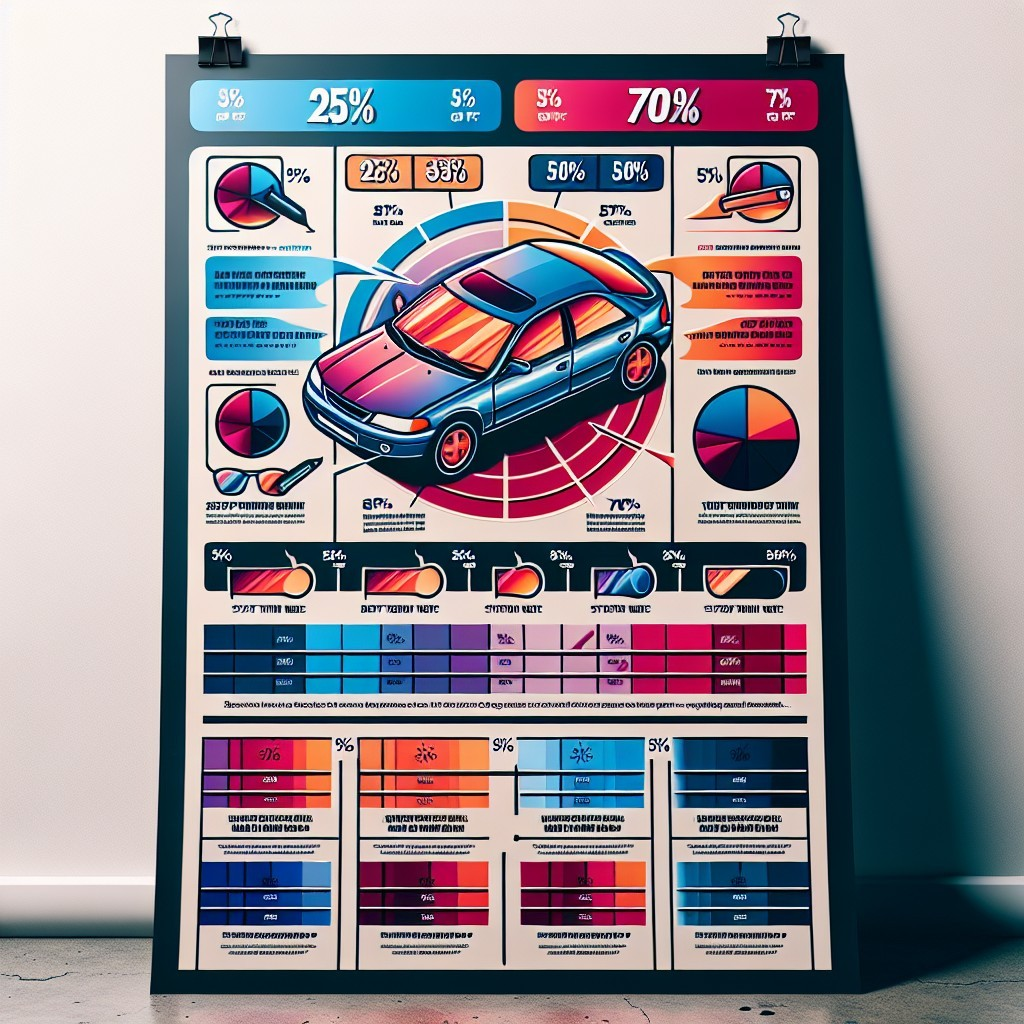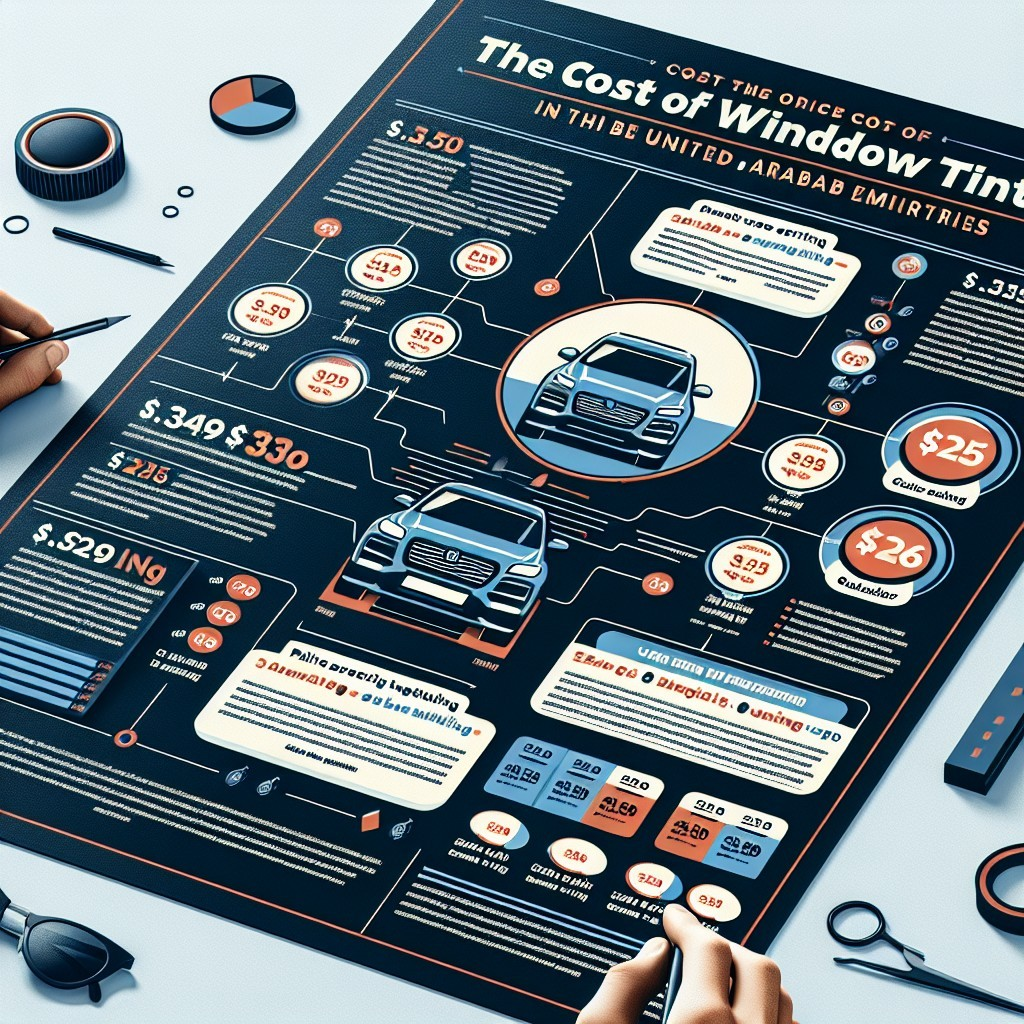When it comes to personalizing your vehicle, one of the most impactful changes you can make is window tinting. Not only does it elevate the aesthetic appeal of your car, but it also offers a range of practical benefits such as UV protection, increased privacy, and temperature control. However, selecting the right tint percentage can be a daunting task, given the myriad of options available. In this article, we’ll guide you through the process of choosing the perfect tint percentage for your car, addressing key considerations to ensure that your choice meets both your style and functional needs.
Understanding Tint Percentage
The tint percentage refers to the amount of light that can pass through your car windows, often expressed as a percentage. A lower percentage indicates darker tinting, while a higher percentage means lighter tinting. For example, a 5% tint allows only 5% of the light to enter, making it very dark, while a 70% tint permits 70% of the light, resulting in a much lighter appearance. Understanding these percentages is crucial, as they significantly influence visibility, privacy, and compliance with local laws.
1. Legal Regulations
Before diving into aesthetic preferences, it’s essential to check your local laws regarding window tinting. Each state has specific regulations concerning the allowable tint percentages for different windows. Typically, front windshields must allow a higher percentage of light compared to rear windows. Failing to comply with these regulations can result in fines and the need to remove the tint. Always research the laws in your area to avoid any legal complications.
2. Purpose of Tinting
Consider what you hope to achieve with the tint. Are you primarily looking for privacy, UV protection, or aesthetic enhancement? Here are some common purposes:
- Privacy: If privacy is your primary concern, a darker tint (20% or lower) is advisable. This provides a shield from prying eyes while still allowing some light to enter.
- Heat Reduction: For those living in hotter climates, a medium tint (35-50%) can significantly reduce heat buildup in the car while still allowing enough light for visibility.
- Aesthetic Appeal: If you’re looking for a stylish upgrade, a lighter tint (50-70%) can enhance your car’s appearance without compromising visibility.
3. Consider Visibility
While darker tints offer greater privacy, they can also reduce visibility, particularly at night or in low-light conditions. If you frequently drive at night, consider opting for a medium tint (30-50%) that balances privacy and visibility. This ensures you maintain a clear view while still enjoying the benefits of tinted windows.
4. Interior Protection
Window tinting is not just about looks; it also plays a vital role in protecting your vehicle’s interior. High-quality tints can block up to 99% of harmful UV rays, which helps prevent fading of upholstery and reduces heat accumulation. If interior preservation is important to you, consider a medium to dark tint that offers maximum UV protection while still complying with local laws.
5. Consultation with Professionals
If you’re still unsure about the right tint percentage for your car, consulting with a professional tinting service can provide valuable insights. Experienced professionals can advise you based on your vehicle type, local regulations, and personal preferences. They can also show you samples and help you visualize how different percentages will look on your car.
Choosing the right tint percentage for your car is a decision that balances aesthetics, functionality, and compliance with legal standards. By considering factors like local regulations, intended purpose, visibility concerns, and interior protection, you can make an informed choice. Remember, the perfect tint not only enhances your vehicle’s appearance but also provides protection and comfort for you and your passengers. So take your time, do your research, and enjoy the process of transforming your ride!
6. Maintenance and Longevity
Once you’ve selected the right tint percentage, understanding how to maintain it is critical for ensuring its longevity. Quality window tints can last for years, but exposure to harsh conditions, improper cleaning techniques, or low-quality materials can lead to fading or bubbling. To keep your tint looking fresh:
- Use the Right Cleaning Products: Avoid ammonia-based cleaners, as they can damage the tint. Instead, opt for a gentle soap solution or a specialized window tint cleaner.
- Gentle Cleaning Techniques: Use a soft microfiber cloth to clean your windows. This prevents scratching and helps maintain the clarity of the film.
- Avoid Excessive Heat: Parking in direct sunlight for extended periods can weaken the adhesive of the tint. Whenever possible, park in shaded areas or use sunshades.
7. Aesthetics vs. Practicality
While aesthetics play a significant role in your tint selection, don’t overlook practicality. A darker tint might look sleek and stylish, but it may also result in higher temperatures inside the car on sunny days if it’s too dark, especially for front windows. Balancing your desire for a fashionable look with practical considerations, such as visibility and heat rejection, is crucial. Think about how often you’re in your vehicle during daylight hours and the level of comfort you seek.
8. Personal Taste and Style
Your car is often a reflection of your personality, so it’s essential to choose a tint that resonates with your style. Whether you lean towards a classic look with a lighter tint or an edgy vibe with something darker, consider how the tint complements your vehicle’s color and design. Experimenting with different shades can also lead to exciting discoveries about your taste. Many tinting services offer swatches or samples, allowing you to visualize how different percentages will alter your car’s appearance.
9. The Impact of Tint Technology
Keep in mind that not all window tints are created equal. Advances in tint technology have led to various types, including dyed, metalized, and ceramic films. Each type has different properties that can affect the tint percentage’s effectiveness in terms of heat rejection, UV protection, and glare reduction. Researching and understanding these technologies can guide you in selecting a tint that not only looks good but also performs well.
10. Final Decision and Installation
Once you’ve weighed all considerations, it’s time to make your final decision. Document your preferences and any legal restrictions, and visit a reputable tinting professional for installation. A skilled technician will ensure that the tint is applied correctly, minimizing the risk of bubbles and imperfections. Remember, the installation quality can greatly affect the appearance and durability of your window tint.
Choosing the right tint percentage for your car is more than just a cosmetic decision; it’s a blend of personal style, legal compliance, and practical benefits. By understanding the factors at play—from local regulations and visibility to maintenance and technology—you can make an informed choice that enhances your driving experience. With the right tint, you’ll not only enjoy a cooler, more comfortable ride but also an elevated sense of style that turns heads on the road. So gear up, explore your options, and let your car reflect the best version of you.
Tinting your car windows is not just about aesthetics; it’s about comfort, privacy, and safety. However, with a plethora of options available, choosing the right tint percentage can be confusing. Here’s a comprehensive guide to help you navigate through the choices.
Understanding Tint Percentages
Tint percentages indicate how much light is allowed to pass through the window film. A lower percentage means darker tint, while a higher percentage allows more light in. For example:
- 5% Tint: Known as “limo tint,” this offers maximum privacy but may hinder visibility at night.
- 20% Tint: Offers a good balance of privacy and visibility, commonly used for sedans.
- 35% Tint: The most popular choice, allowing a moderate amount of light while providing some privacy.
- 50% Tint: Great for those who want a subtle look without drastically altering visibility.
Consider Local Laws
Before making any decisions, it’s crucial to familiarize yourself with your local tinting laws. Regulations vary from state to state, and what might be acceptable in one area could land you a ticket in another. Always check:
- Maximum allowable tint percentage for front and rear windows.
- Reflectivity limits, if applicable.
- Exemptions that might apply to specific vehicle types.
Evaluate Your Needs
Your lifestyle and driving habits should heavily influence your choice of tint percentage. Consider questions like:
- Do you often drive during the day or at night?
- Is privacy a major concern for you?
- Do you frequently park in sunny areas?
Think About Aesthetics
The visual appeal of your vehicle plays a significant role in your decision. Different tint levels create different looks, so think about how the tint will complement your car’s color and style. For instance:
- A darker tint can lend a sleek, luxurious look.
- Lighter tints can maintain a more understated appearance while still providing benefits.
Assess Heat and UV Protection
Tinting serves a practical purpose beyond style. High-quality window films can block a significant amount of heat and harmful UV rays. When choosing a tint percentage, consider:
- How much heat reduction do you need?
- Do you have sensitive skin or health concerns related to UV exposure?
Consult Professionals
If you’re unsure about which tint percentage to choose, consult with professionals. Reputable tinting shops will have experience working with various vehicles and can recommend options based on your preferences and needs.

Final Thoughts
Choosing the right tint percentage for your car involves balancing personal style, legal compliance, and practical benefits. By carefully considering your options and consulting experts when necessary, you can select a tint that enhances your driving experience. Remember, the right tint not only adds to your vehicle’s aesthetic but also contributes to your comfort and safety on the road.
This HTML document provides a structured, engaging article on how to choose the right tint percentage for a car, complete with headings, lists, and clear formatting to enhance readability.


This article is incredibly informative! I had no idea there were so many factors to consider when choosing window tint. The breakdown of tint percentages was especially helpful!
Fantastic read! I’ve been considering tinting my windows for a while, and this article has given me the clarity I needed. The tips on purpose were spot on!
What a great resource for anyone looking to personalize their vehicle! The details about UV protection and temperature control are very useful. Thank you for sharing!
I loved this article! It breaks down everything you need to know about window tinting in an easy-to-understand way. Now I feel ready to make an informed decision!
I really appreciated the section on legal regulations. It’s crucial to know what’s allowed in your area before making any decisions. Great job on this guide!